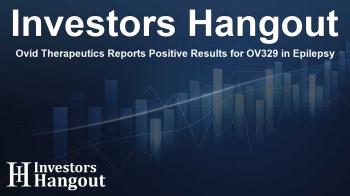Ovid Therapeutics Reports Positive Results for OV329 in Epilepsy

Transforming Epilepsy Treatment with OV329
Ovid Therapeutics Inc. (NASDAQ: OVID) recently shared some exciting news regarding OV329, a promising next-generation GABA-aminotransferase (GABA-AT) inhibitor that may revolutionize the treatment landscape for epilepsy. The results from a Phase 1 study on healthy volunteers revealed significant inhibitory activity and a favorable safety profile, marking a significant step for Ovid in their mission to address persistent issues in treating epilepsy and related disorders.
Significant Findings from the Phase 1 Study
The Phase 1 study, which included 68 healthy participants, demonstrated that OV329 achieved statistically significant inhibition of GABA-AT across multiple evaluation metrics. Notably, OV329 matched or even exceeded the inhibition levels typically seen with first-generation GABA-AT inhibitors such as vigabatrin. This finding is instrumental as it signifies that OV329 can potentially deliver enhanced efficacy without some of the side effects associated with older treatments.
Statements from Ovid Leadership
Dr. Jeremy Levin, chairman and CEO of Ovid Therapeutics, expressed excitement about the findings, stating, "Our study showcased OV329's capability to improve upon existing treatments by proving effective results while maintaining a clean safety profile." The comprehensive biomarker program supporting these results further boosts confidence in OV329's therapeutic potential against epilepsy.
Advancing Towards Phase 2a Studies
Following this encouraging data, Ovid plans to move OV329 into a Phase 2a study targeting drug-resistant focal onset seizures. The goal is to begin this trial within the next two years, emphasizing Ovid's commitment to pushing the boundaries of treatment options for patients suffering from epilepsy. Concurrently, Ovid is also finalizing preparations for its first oral KCC2 direct activator, OV4071, anticipating regulatory filings by early 2026.
Trial Design and Study Parameters
The study design was robust, with 51 participants receiving the active treatment of OV329 and 17 receiving a placebo. The doses administered ranged from 1 mg to 5 mg, with the research emphasizing not just efficacy but also safety, pharmacokinetics (PK), and pharmacodynamics (PD). Detailed assessments including transcranial magnetic stimulation (TMS) were employed to evaluate the drug's effects on brain activity, showcasing OV329's ability to effectively penetrate the brain.
Clinical Insights: A New Path for GABA-AT Inhibition
OV329's efficacy was reflected in several key metrics. For instance, results indicated that a 5 mg dose of OV329 was associated with a 53% increase in inhibitory activity compared to baseline, a striking improvement compared to the placebo group. This compelling data suggests that OV329 could be a frontrunner in its category as a GABA-AT inhibitor.
Safety Profile and Tolerability
Crucially, the safety evaluation highlighted that all potential treatment-related adverse events were mild and transient, reinforcing OV329's benign safety profile. Experts involved in the study, such as Dr. Alexander Rotenberg from Boston Children's Hospital, applauded the findings, indicating that evidence supports moving forward with patient trials.
Looking Ahead: Ovid's Pipeline and Future Directions
Ovid is not just stopping at OV329. The company has a pipeline filled with innovative candidates designed to modulate neuronal excitability. In addition to OV329, their KCC2 activation portfolio, including compounds like OV350 and OV4071, is expected to mature in the coming years with critical clinical milestones on the horizon.
Join the Conversation
This is an exciting time for Ovid Therapeutics as they lay the groundwork for potentially life-changing treatments for those living with epilepsy and related conditions. With significant trials and data presentations planned for the near future, stakeholders and interested parties are encouraged to stay tuned for unfolding developments. The management will hold a conference call to discuss these findings further, offering an opportunity for dialogue regarding the clinical advancements expected in the near term.
Frequently Asked Questions
What is OV329 and its intended use?
OV329 is a GABA-aminotransferase inhibitor being developed for treating drug-resistant epilepsy and related seizure disorders.
What were the key results from the Phase 1 study for OV329?
The Phase 1 study showed significant inhibition of GABA-AT and a much cleaner safety profile than existing therapies like vigabatrin.
When does Ovid plan to start Phase 2a trials for OV329?
Ovid intends to initiate the Phase 2a trial targeting drug-resistant focal onset seizures in the next two years.
How does OV329 compare with existing GABA-AT inhibitors?
OV329 has shown to achieve comparable or superior efficacy compared to first-generation inhibitors while maintaining a better safety profile.
Who leads Ovid Therapeutics?
Ovid Therapeutics is led by Dr. Jeremy Levin, who serves as chairman and CEO, overseeing the company's innovative therapeutic advancements.
About The Author
Contact Evelyn Baker privately here. Or send an email with ATTN: Evelyn Baker as the subject to contact@investorshangout.com.
About Investors Hangout
Investors Hangout is a leading online stock forum for financial discussion and learning, offering a wide range of free tools and resources. It draws in traders of all levels, who exchange market knowledge, investigate trading tactics, and keep an eye on industry developments in real time. Featuring financial articles, stock message boards, quotes, charts, company profiles, and live news updates. Through cooperative learning and a wealth of informational resources, it helps users from novices creating their first portfolios to experts honing their techniques. Join Investors Hangout today: https://investorshangout.com/
The content of this article is based on factual, publicly available information and does not represent legal, financial, or investment advice. Investors Hangout does not offer financial advice, and the author is not a licensed financial advisor. Consult a qualified advisor before making any financial or investment decisions based on this article. This article should not be considered advice to purchase, sell, or hold any securities or other investments. If any of the material provided here is inaccurate, please contact us for corrections.

